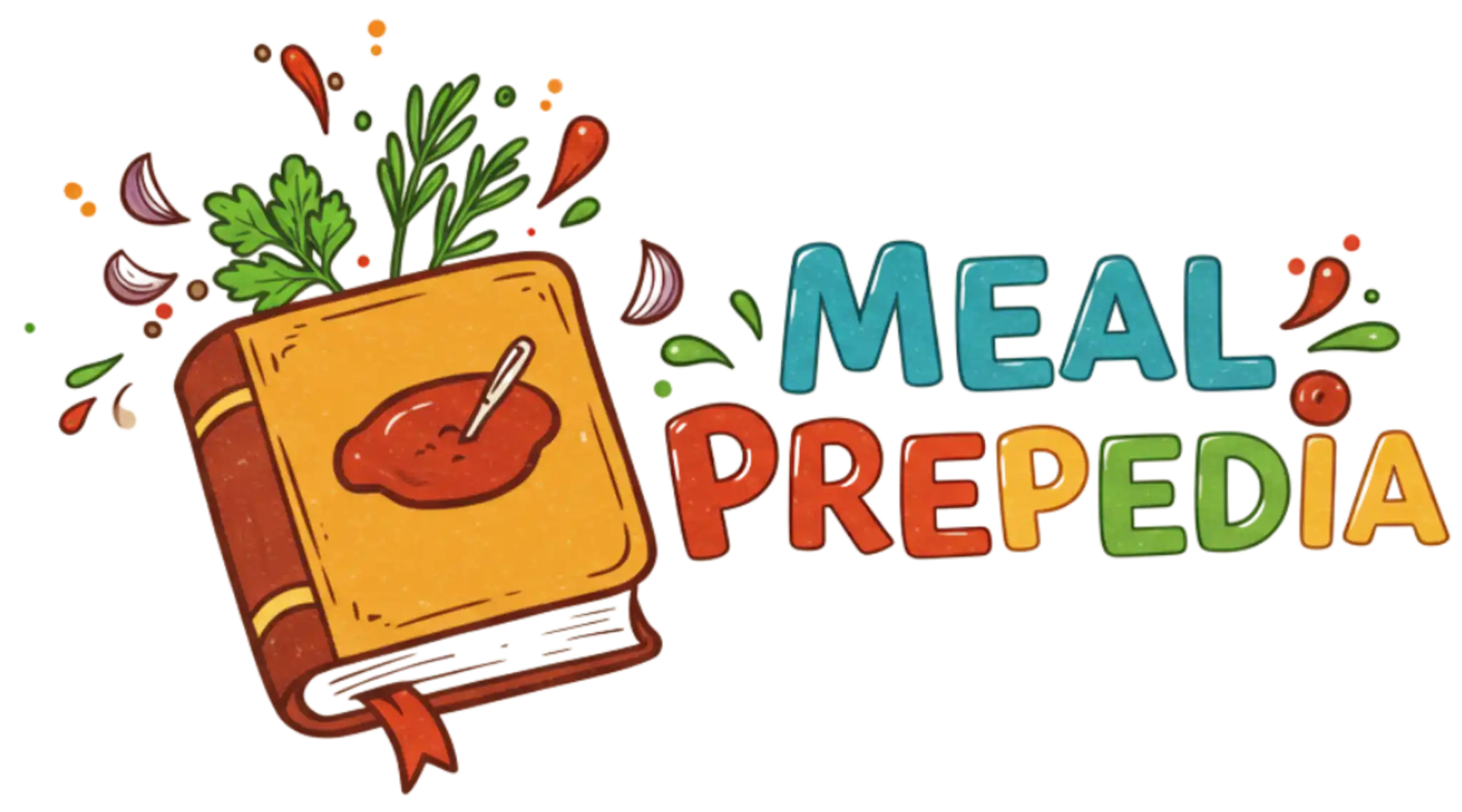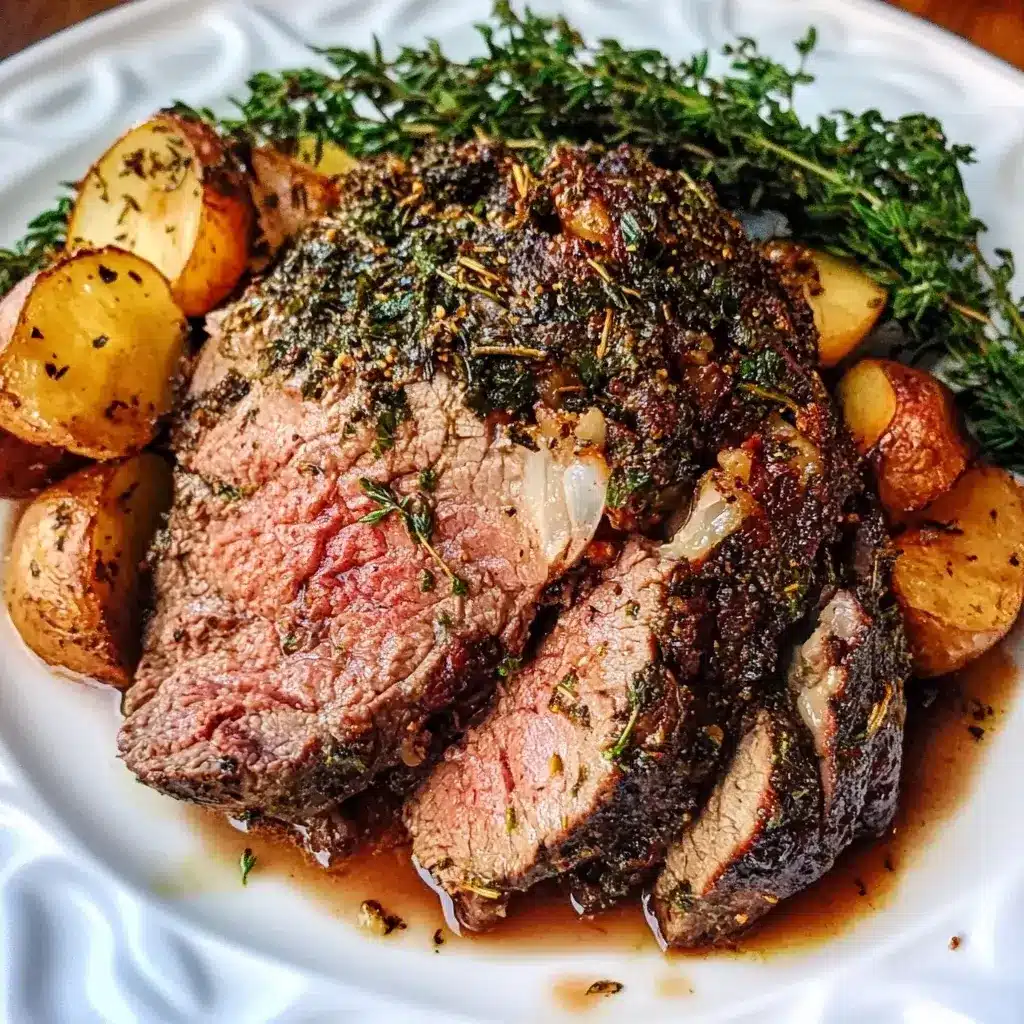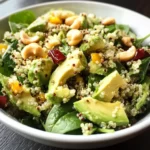It was a chilly Sunday afternoon, the kind where the promise of spring is in the air, but winter still has a bit of a bite. I wanted a meal that felt both comforting and fresh, something that bridged the gap between hearty winter fare and the lighter flavors of spring. That’s when I stumbled upon this Spring Herb Beef Roast recipe, and let me tell you, it was an absolute revelation. The aroma alone, as the beef roasted in the oven, infused with rosemary, thyme, and garlic, was enough to make everyone’s mouth water. My family, usually a tough crowd to please when it comes to trying new dishes, devoured it. Even my youngest, who typically prefers chicken nuggets, went back for seconds, praising the “yummy herbs” and the tenderness of the beef. This roast has become a new family favorite, a perfect centerpiece for a spring gathering or a special Sunday dinner. It’s surprisingly easy to prepare, yet yields a restaurant-quality result that’s bursting with flavor and freshness. If you’re looking for a roast that’s both impressive and approachable, look no further. This Spring Herb Beef Roast is guaranteed to become a staple in your kitchen, just like it has in mine.
Ingredients
- 3-4 lb Chuck Roast: Choose a well-marbled chuck roast for the most tender and flavorful results. Marbling refers to the streaks of fat within the meat, which melt during cooking, adding moisture and richness.
- 1/4 cup Olive Oil: Extra virgin olive oil is preferred for its flavor and health benefits. It helps to create a flavorful crust on the roast and aids in browning.
- 4 cloves Garlic: Fresh garlic cloves, minced. Garlic adds a pungent and savory depth of flavor that complements the herbs and beef beautifully.
- 2 tablespoons Fresh Rosemary: Finely chopped fresh rosemary. Rosemary provides a piney, aromatic, and slightly peppery flavor that is classic with beef.
- 2 tablespoons Fresh Thyme: Finely chopped fresh thyme. Thyme offers a slightly earthy and minty flavor that pairs well with rosemary and beef.
- 1 tablespoon Fresh Parsley: Finely chopped fresh parsley. Parsley adds a fresh, clean, and slightly peppery note, brightening up the herb blend.
- 1 Lemon: Zest of one lemon. Lemon zest provides a bright, citrusy aroma and flavor that cuts through the richness of the beef and enhances the spring freshness.
- 1 teaspoon Salt: Kosher salt or sea salt. Salt is essential for seasoning and enhancing the natural flavors of the beef and herbs.
- 1/2 teaspoon Black Pepper: Freshly ground black pepper. Black pepper adds a warm, pungent spice that complements the other flavors.
- 1 cup Beef Broth: Low-sodium beef broth. Beef broth adds moisture to the roasting pan, creating flavorful pan juices that can be used for a simple gravy or au jus.
- Optional: 1 cup Dry Red Wine: A dry red wine like Cabernet Sauvignon or Merlot. Red wine adds depth and richness to the pan juices, creating a more complex flavor profile.
Instructions
- Preheat the Oven and Prepare the Roast: Preheat your oven to 325°F (160°C). Remove the chuck roast from the refrigerator and let it sit at room temperature for about 30 minutes. This helps the roast cook more evenly. Pat the roast dry with paper towels. Drying the surface of the beef is crucial for achieving a good sear and flavorful crust.
- Make the Herb Rub: In a small bowl, combine the olive oil, minced garlic, chopped rosemary, chopped thyme, chopped parsley, lemon zest, salt, and black pepper. Mix well to create a fragrant herb rub. This herb mixture is the heart of the flavor in this recipe, infusing the beef with aromatic spring notes.
- Rub the Roast: Place the chuck roast in a roasting pan. Generously rub the herb mixture all over the roast, ensuring all sides are well coated. Massage the rub into the meat, getting into all the crevices. This step ensures that every bite is infused with the delicious herb flavors.
- Add Broth (and Wine if using): Pour the beef broth into the bottom of the roasting pan. If using red wine, add it to the pan as well. The liquid in the pan will create steam, helping to keep the roast moist and developing flavorful pan juices.
- Roast the Beef: Place the roasting pan in the preheated oven. Roast for approximately 3-4 hours, or until the beef is fork-tender. The cooking time will vary depending on the size and thickness of your roast. For a 3-4 lb roast, start checking for tenderness around the 3-hour mark. You want the beef to be easily pierced with a fork and shreddable.
- Check for Doneness: To check for doneness, insert a fork into the thickest part of the roast. If it easily pulls apart and is very tender, it’s ready. If you prefer to use a meat thermometer, the internal temperature for a well-done chuck roast should be around 200-205°F (93-96°C). Chuck roast is best cooked to well-done for optimal tenderness as the connective tissues break down over longer cooking times.
- Rest the Roast: Once the roast is cooked, remove it from the oven and transfer it to a cutting board. Tent it loosely with foil and let it rest for at least 15-20 minutes before carving. Resting allows the juices to redistribute throughout the meat, resulting in a more tender and flavorful roast. Do not skip this crucial step!
- Carve and Serve: After resting, carve the chuck roast against the grain into thick slices or shred it using two forks. Serve immediately, spooning the flavorful pan juices over the beef. The pan juices are packed with flavor from the herbs and beef drippings and make a delicious natural gravy.
Nutrition Facts
(Per Serving, Estimated – Servings: 6-8)
- Calories: Approximately 450-550 kcal: Calories provide energy for the body. This is an estimated range and can vary based on the specific cut of beef and portion size.
- Protein: Approximately 40-50g: Protein is essential for building and repairing tissues, as well as for various bodily functions. Beef is an excellent source of high-quality protein.
- Fat: Approximately 25-35g: Fat provides energy and is important for hormone production and nutrient absorption. The fat content will vary depending on the marbling of the beef.
Note: Nutritional information is an estimate and can vary based on specific ingredients and portion sizes. It’s always best to consult a nutritional database for more precise values if needed.
Preparation Time
- Prep Time: 20 minutes: This includes the time to chop the herbs, mince the garlic, zest the lemon, and prepare the herb rub. The recipe is quite straightforward and requires minimal hands-on preparation.
- Cook Time: 3-4 hours: The majority of the cooking time is hands-off, allowing you to focus on other tasks while the roast slowly cooks in the oven. Slow roasting is key to achieving tender and flavorful chuck roast.
- Resting Time: 15-20 minutes: Resting time is crucial for optimal tenderness and juiciness. Factor this time into your meal planning.
- Total Time: Approximately 3 hours 35 minutes – 4 hours 40 minutes: This includes all stages from preparation to resting, providing a realistic timeframe for making this delicious roast.
How to Serve
This Spring Herb Beef Roast is incredibly versatile and pairs beautifully with a variety of side dishes. Here are some serving suggestions:
- Classic Mashed Potatoes: Creamy mashed potatoes are a perfect accompaniment to soak up the flavorful pan juices.
- Roasted Root Vegetables: Carrots, potatoes, and parsnips roasted with olive oil and herbs complement the roast beautifully, adding sweetness and earthy notes.
- Spring Asparagus: Lightly steamed or roasted asparagus with a squeeze of lemon juice adds a fresh, seasonal touch.
- Green Beans Almondine: Sautéed green beans with toasted almonds provide a delightful crunch and vibrant green color.
- Creamy Polenta: Soft and creamy polenta is another excellent option for soaking up the pan juices and offers a comforting texture.
- Yorkshire Pudding: For a truly special occasion, serve with homemade Yorkshire pudding to capture every last drop of gravy.
- Crusty Bread: A simple loaf of crusty bread is perfect for enjoying alongside the roast and soaking up the delicious pan juices.
- Simple Green Salad: A fresh green salad with a light vinaigrette provides a refreshing contrast to the richness of the roast.
Additional Tips for the Perfect Spring Herb Beef Roast
- Choose the Right Cut of Beef: While this recipe calls for chuck roast, other cuts like brisket or even a sirloin tip roast can also be used, though cooking times may vary. Chuck roast is preferred for its marbling and flavor when slow-roasted.
- Don’t Skimp on the Herbs: Fresh herbs are key to the vibrant flavor of this dish. Use a generous amount of fresh rosemary, thyme, and parsley for the best results. Dried herbs can be used in a pinch, but fresh herbs provide a brighter and more aromatic flavor.
- Sear for Extra Flavor (Optional): For an even deeper flavor, you can sear the chuck roast in a hot pan with olive oil before roasting. Sear all sides until browned to create a flavorful crust. This step adds an extra layer of richness but is not essential for a delicious roast.
- Adjust Herbs to Your Preference: Feel free to customize the herb blend to your liking. Other spring herbs like chives, dill, or oregano would also be delicious additions. Experiment with different combinations to find your favorite flavor profile.
- Deglaze the Pan for Richer Gravy: After removing the roast, deglaze the roasting pan by placing it over medium heat and adding a splash of red wine or beef broth. Scrape up any browned bits from the bottom of the pan. This creates a richer and more flavorful base for your gravy or au jus.
- Make a Simple Gravy: To make a simple gravy, strain the pan juices and skim off any excess fat. In a saucepan, melt butter, whisk in flour, and cook for a minute. Gradually whisk in the strained pan juices until the gravy thickens to your desired consistency. Season with salt and pepper to taste.
- Use a Meat Thermometer for Accuracy: While fork tenderness is a good indicator, a meat thermometer ensures accurate doneness. Insert the thermometer into the thickest part of the roast, avoiding bone. Aim for an internal temperature of 200-205°F (93-96°C) for a well-done, tender chuck roast.
- Leftovers are Delicious: Leftover Spring Herb Beef Roast is fantastic! Shred it and use it in sandwiches, tacos, shepherd’s pie, or beef stew. The flavor often intensifies overnight, making it even more delicious the next day. Store leftovers in an airtight container in the refrigerator for up to 3-4 days.
Frequently Asked Questions (FAQ)
Q1: Can I use a different cut of beef for this recipe?
A: Yes, while chuck roast is recommended for its flavor and tenderness when slow-roasted, you can use other cuts like brisket, sirloin tip roast, or even a rump roast. Keep in mind that cooking times may vary depending on the cut and its size. Adjust cooking time and temperature accordingly.
Q2: Can I use dried herbs instead of fresh herbs?
A: Fresh herbs are highly recommended for the best and brightest flavor in this Spring Herb Beef Roast. However, if you only have dried herbs available, you can use them. As a general rule, use about 1 teaspoon of dried herbs for every tablespoon of fresh herbs. Dried herbs have a more concentrated flavor, so you need less.
Q3: How do I know when the beef roast is done?
A: The best way to check for doneness is by using a meat thermometer. For a well-done chuck roast that is tender and shreddable, aim for an internal temperature of 200-205°F (93-96°C). You can also check for fork tenderness – the roast should easily pull apart when pierced with a fork.
Q4: Can I prepare this roast ahead of time?
A: While it’s best served fresh, you can prepare the herb rub and apply it to the roast up to 24 hours in advance. Store the rubbed roast covered in the refrigerator until ready to cook. This can actually enhance the flavor as the herbs have more time to penetrate the meat.
Q5: What if I don’t have beef broth? Can I use something else?
A: If you don’t have beef broth, you can substitute it with chicken broth, vegetable broth, or even water. However, beef broth will provide the richest flavor and complement the beef best. Using red wine in addition to or instead of broth can also add depth of flavor.
Q6: How should I store leftover Spring Herb Beef Roast?
A: Store leftover beef roast in an airtight container in the refrigerator. It will keep for up to 3-4 days. Reheat gently in the oven or microwave until heated through. Shredded leftover roast is also great for freezing for longer storage (up to 2-3 months).
Q7: Can I add vegetables to the roasting pan with the beef?
A: Absolutely! Roasting vegetables alongside the beef is a great way to make it a complete one-pan meal. Add hearty vegetables like carrots, potatoes, onions, and parsnips to the roasting pan about halfway through the cooking time, ensuring they are cut into similar sizes to cook evenly.
Q8: What wine pairings would you recommend with this Spring Herb Beef Roast?
A: A medium-bodied red wine like Merlot, Cabernet Sauvignon, or a Chianti Classico would pair beautifully with this herb-infused beef roast. The earthy and herbal notes in these wines complement the flavors of the roast perfectly. For a lighter option, a dry rosé or a full-bodied white wine like Chardonnay could also work well.

Spring Herb Beef Roast
Ingredients
- 3–4 lb Chuck Roast: Choose a well-marbled chuck roast for the most tender and flavorful results. Marbling refers to the streaks of fat within the meat, which melt during cooking, adding moisture and richness.
- 1/4 cup Olive Oil: Extra virgin olive oil is preferred for its flavor and health benefits. It helps to create a flavorful crust on the roast and aids in browning.
- 4 cloves Garlic: Fresh garlic cloves, minced. Garlic adds a pungent and savory depth of flavor that complements the herbs and beef beautifully.
- 2 tablespoons Fresh Rosemary: Finely chopped fresh rosemary. Rosemary provides a piney, aromatic, and slightly peppery flavor that is classic with beef.
- 2 tablespoons Fresh Thyme: Finely chopped fresh thyme. Thyme offers a slightly earthy and minty flavor that pairs well with rosemary and beef.
- 1 tablespoon Fresh Parsley: Finely chopped fresh parsley. Parsley adds a fresh, clean, and slightly peppery note, brightening up the herb blend.
- 1 Lemon: Zest of one lemon. Lemon zest provides a bright, citrusy aroma and flavor that cuts through the richness of the beef and enhances the spring freshness.
- 1 teaspoon Salt: Kosher salt or sea salt. Salt is essential for seasoning and enhancing the natural flavors of the beef and herbs.
- 1/2 teaspoon Black Pepper: Freshly ground black pepper. Black pepper adds a warm, pungent spice that complements the other flavors.
- 1 cup Beef Broth: Low-sodium beef broth. Beef broth adds moisture to the roasting pan, creating flavorful pan juices that can be used for a simple gravy or au jus.
- Optional: 1 cup Dry Red Wine: A dry red wine like Cabernet Sauvignon or Merlot. Red wine adds depth and richness to the pan juices, creating a more complex flavor profile.
Instructions
- Preheat the Oven and Prepare the Roast: Preheat your oven to 325°F (160°C). Remove the chuck roast from the refrigerator and let it sit at room temperature for about 30 minutes. This helps the roast cook more evenly. Pat the roast dry with paper towels. Drying the surface of the beef is crucial for achieving a good sear and flavorful crust.
- Make the Herb Rub: In a small bowl, combine the olive oil, minced garlic, chopped rosemary, chopped thyme, chopped parsley, lemon zest, salt, and black pepper. Mix well to create a fragrant herb rub. This herb mixture is the heart of the flavor in this recipe, infusing the beef with aromatic spring notes.
- Rub the Roast: Place the chuck roast in a roasting pan. Generously rub the herb mixture all over the roast, ensuring all sides are well coated. Massage the rub into the meat, getting into all the crevices. This step ensures that every bite is infused with the delicious herb flavors.
- Add Broth (and Wine if using): Pour the beef broth into the bottom of the roasting pan. If using red wine, add it to the pan as well. The liquid in the pan will create steam, helping to keep the roast moist and developing flavorful pan juices.
- Roast the Beef: Place the roasting pan in the preheated oven. Roast for approximately 3-4 hours, or until the beef is fork-tender. The cooking time will vary depending on the size and thickness of your roast. For a 3-4 lb roast, start checking for tenderness around the 3-hour mark. You want the beef to be easily pierced with a fork and shreddable.
- Check for Doneness: To check for doneness, insert a fork into the thickest part of the roast. If it easily pulls apart and is very tender, it’s ready. If you prefer to use a meat thermometer, the internal temperature for a well-done chuck roast should be around 200-205°F (93-96°C). Chuck roast is best cooked to well-done for optimal tenderness as the connective tissues break down over longer cooking times.
- Rest the Roast: Once the roast is cooked, remove it from the oven and transfer it to a cutting board. Tent it loosely with foil and let it rest for at least 15-20 minutes before carving. Resting allows the juices to redistribute throughout the meat, resulting in a more tender and flavorful roast. Do not skip this crucial step!
- Carve and Serve: After resting, carve the chuck roast against the grain into thick slices or shred it using two forks. Serve immediately, spooning the flavorful pan juices over the beef. The pan juices are packed with flavor from the herbs and beef drippings and make a delicious natural gravy.
Nutrition
- Serving Size: one normal portion
- Calories: 550
- Fat: 35g
- Protein: 50g






